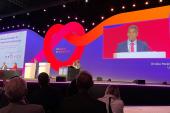Top Heart Failure News of 2022
Positive heart failure trials continued to bask in the spotlight at cardiology meetings in 2022, but a few key studies came up short.

Some of the biggest advances in cardiology this year fell under the umbrella of heart failure care. Leading the way were gains made by sodium-glucose cotransporter 2 (SGLT2) inhibitors across the spectrum of ejection fraction. Notable moments include the unveiling of the positive results from DELIVER (31 Across) at the European Society of Cardiology (ESC) Congress in Barcelona, as well as the US Food and Drug Administration’s decision to expand the indication for empagliflozin or “empa” (16 Down) to include patients with preserved ejection fraction.
New heart failure guidelines in the United States, a joint effort of the American College of Cardiology (ACC), the American Heart Association (AHA), and the Heart Failure Society of America (HFSA), incorporated empagliflozin’s expanded role; they also made way for heart failure with midrange ejection fraction, or HFmrEF (17 Across), previously formalized by the 2016 ESC guidance, to capture the group of patients whose EF was not quite normal, but not markedly reduced either, who might benefit from certain medications for heart failure with reduced ejection fraction (HFrEF). Also emphasized in the guidelines was the need for rapid uptitration of guideline-directed medical therapy (GDMT; 24 Across), a point reinforced later in the year with the STRONG-HF trial.
This year also saw the ascendency of two new medications for obstructive hypertrophic cardiomyopathy. Mavacamten (30 Across) was approved by the FDA in late April. Another allosteric inhibitor of cardiac myosin, aficamten (5 Down), also cleared several phase II hurdles with the REDWOOD-HCM OLE study.
One of the most hotly anticipated trials of the year, however, did not deliver the hoped-for success. REVIVED-BCIS2 (REVIVED; 52 Down) arrived with a thump, showing that PCI fails to provide any additional benefit beyond optimal medical therapy in patients with severely impaired left ventricular function and extensive coronary artery disease. IRONMAN, likewise, failed to demonstrate a statistically significant benefit to intravenous repletion of iron (62 Down) in heart failure patients, although many greeted the trial as supportive of this approach on the basis of a COVID-19-censored analysis.
Throughout most of the year, a countrywide dobutamine (50 Down) shortage in the US left heart failure specialists, surgeons, and the patients in their care scrambling for alternatives, and prompted a quickly convened task force to swiftly formulate recommendations for handling the shortfall.
One of the big stories of the year, reaching beyond the cardiology community, was the first use of a genetically modified pig heart for xenotransplantation (1 Across) for a patient with end-stage heart disease, a procedure authorized by the FDA under its compassionate use provision given that the patient was not eligible for a human heart transplant or ventricular assist device. The patient, David Bennett (65 Across), survived nearly 2 months before dying of causes that, if known, were never released to the public.
What Else?
Did we miss anything in our Crossword Challenge? TCTMD checked in with Shelley Zieroth, MD (University of Manitoba, Winnipeg, Canada), to hear her top picks for major heart failure news in 2022. Topping Zieroth’s list were STRONG-HF, the new ACC/AHA/HFSA guidelines, and mavacamten, specifically the VALOR-HCM trial, which showed that the myosin inhibitor reduced the need for surgical or interventional septal reduction therapy in patients with obstructive hypertrophic cardiomyopathy.
EMPULSE—which was presented in late 2021, but not published until February 2022—also got the nod from Zieroth, as did DELIVER, particularly the subgroup analyses showing that dapagliflozin (Farxiga; AstraZeneca) was effective in patients with improved ejection fraction as well as in those with mildly reduced EF.
Zieroth also mentioned IRONMAN and ADVOR, but both of these, she said, don’t truly deserve top billing. IRONMAN, she said, “wasn’t that impressive,” while ADVOR, which tested the 70-year-old drug acetazolamide, typically used to treat mountain sickness and some types of glaucoma, “wasn’t a major win,” she said. Both the improvement in successful decongestion compared with placebo, as well as the reduction in length of stay (just 1 day) with acetazolamide “doesn’t really read like that’s an overwhelming celebration for patients.”
In the last few weeks of the year, HF specialists got some unaccustomed bad news: members of the FDA’s Cardiovascular and Renal Drugs Advisory Committee voted 8 to 3 against approving omecamtiv mecarbil, a novel cardiac myosin activator developed to improve cardiac performance, for the treatment of patients who have HFrEF.
Shelley Wood was the Editor-in-Chief of TCTMD and the Editorial Director at the Cardiovascular Research Foundation (CRF) from October 2015…
Read Full Bio




Comments